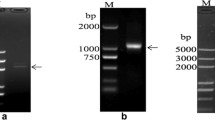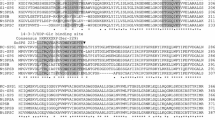Abstract
We have previously reported the isolation of a gene from a soybean cDNA library encoding a Ypt/Rab-related small GTP-binding protein, Sypt. Here, we report the isolation of a second Ypt/Rab-related gene, designated Srab2, from the same soybean cDNA library. And we compare the in vivo function of the two soybean genes utilizing a yeast ypt1-1 mutant. The Srab2 gene encodes 211 amino acid residues with a molecular mass of 23 169 Da. The deduced amino acid sequence of the Srab2 is closely related to the rat (76%) and human (75%) Rab2 proteins, but it shares relatively little homology to Sypt (46%) and Saccharomyces cerevisiae ypt proteins (41%). Genomic Southern blot analysis using the cDNA insert of Srab2 revealed that it belongs to a multigene family in the soybean genome. The protein encoded by Srab2 gene, when expressed in Escherichia coli, disclosed a GTP-binding activity. The expression pattern of the Srab2 gene is quite different from that of the Sypt gene. The Srab2 gene is predominantly expressed in the plumule region, while expression was very low in the other areas in soybean seedlings. On the other hand, the Sypt mRNA is not detectable in any tissues of soybean seedlings grown in the dark. However, light significantly suppressed the Srab2 gene expression, but enhanced the transcript levels of the Sypt gene in leaf and, at even higher levels, in root tissues. When the Srab2 and Sypt genes are introduced separately into a S cerevisiae defective in vesicular transport function, the Srab2 gene cannot complement the temperature-sensitive yeast ypt1-1 mutation at all, in contrast to the Sypt gene. In conclusion, the difference of functional complementation of the yeast mutation together with differential expression of the two genes suggest that the in vivo roles of the Srab2 and Sypt genes may be different in soybean cells.
Similar content being viewed by others
References
Adari H, Lowy DG, Willumsen BM, Der CJ, McCormick F: Guanosine triphosphatase activating protein (GAP) interacts with the p21 ras effector binding domain. Science 240: 518–521 (1988).
Anai T, Hasegawa K, Watanabe Y, Uchimiya H, Ishizaki R, Matusui M: Isolation and analysis of cDNAs encoding small GTP binding proteins of Arabidopsis thaliana genes. Gene 108: 259–264 (1991).
Baker D, Wuestehube L, Shekman R, Botstein D, Segev N: GTP-binding YPT1 protein and Ca++ function independently in a cell free transport reaction. Proc Natl Acad Sci USA 87: 355–359 (1990).
Boguski MS, McCormick F: Proteins regulating ras and its relatives. Nature 366: 643–654 (1993).
Borg S, Poulsen C: Molecular analysis of two Ypt/Rab-related sequences isolated from soybean (Glycine max) DNA libraries. Plant Mol Biol 26: 175–187 (1994).
Bourne HR, Sanders DA, McCormick F: The GTPase super-family: conserved structure and molecular mechanism. Nature 349: 117–127 (1991).
Brennwald P, Novick P: Interactions of three domains distinguishing the Ras-related GTP-binding proteins Ypt1 and Sec4. Nature 362: 560–562 (1993).
Capon DJ, Chen EY, Levinson AD, Seeburg PH, Goeddel DV: Complete nucleotide sequences of the T24 human bladder carcinoma oncogene and its normal homologue. Nature 302: 33–37 (1983).
Chavrier P, Gorvel JP, Stelzer E, Simons K, Gruenberg J, Zerial M: Hypervariable C-terminal domain of rab proteins acts as a targeting signal. Nature 353: 769–772 (1991).
Chavrier P, Parton RG, Hauri HP, Simons K, Zerial M: Localization of low molecular weight GTP binding proteins to exocytic and endocytic compartments. Cell 62: 317–329 (1990).
Cheon CI, Lee NG, Siddique ABM, bal AK, Verma DPS: Roles of plant homologs of Rab1p and Rab7p in the biogenesis of the peribacteriod membrane, a subcellular compartment formed de novo during root nodule symbiosis. EMBO J 12: 4125–4135 (1993).
Cheong NE, Kim WY, Lee HS, Bahk JD, Cho MJ, Lee SY: Molecular characterization of a cDNA encoding a small GTP binding protein, Sypt, in soybean. Plant Physiol 105: 765–766 (1994).
Chomczynski P, Sacchi N: Single step method of RNA isolation by acid guanidium thiocyanate-phenol-chloroform extraction. Anal Biochem 162: 156–159 (1987).
Chardin P, Tavitain A: Coding sequences of human ral A and ral B cDNAs. Nucl Acids Res 17: 4380 (1989).
Dascher C, Ossig R, Gallwitz D, Schmitt HD: Identification and structure of four yeast genes (SLY) that are able to suppress the functional loss of Ypt1, a membrane of the RAS superfamily. Mol Cell Biol 11: 872–885 (1991).
d'Enfert C, Gensse M, Gaillardin C: Fission yeast and a plant have functional homologues of the Sar 1 and Sec 12 proteins involved in ER to Golgi traffic in budding yeast. EMBO J 11: 4205–4211 (1992).
Dellaporta SL, Wood J, Hicks JB: A plant DNA minipreparation: Version I. Plant Mol Biol Rep 1: 19–22 (1983).
Dunn B, Stearns T, Botstein D: Specificity domains distinguish the ras-related GTPases Ypt1 and Sec4. Nature 362: 563–565 (1993).
Gallwitz D, Donath C, Sander C: A yeast gene containing a protein homologous to the human c-has/bas proto-oncogene product. Nature 306: 704–707 (1983).
Goud B, Zahraoui A, Tavitian A, Saraste J: Small GTP binding protein associated with Golgi cisternae. Nature 34: 553–556 (1990).
Grand RJA, Owen D: The biochemistry of ras p21. Biochem J 279: 165–187 (1991).
Hall A: The cellular funcitons of small GTP binding proteins. Science 249: 635–640 (1990).
Haubruck H, Prange R, Vorgias C, Gallwitz D: The ras-related mouse ypt1 protein can functionally replace the Ypt1 gene product in yeast. EMBO J 8: 1427–1432 (1989).
Higgins DG, Sharp PM: Clustal: a package for performing multiple sequence alignment on a microcomputer. Gene 73: 237–244 (1988).
Ito H, Fulude Y, Murata K, Kimura A: Transformation of intact yeast cells treated with alkali cations. J Bacteriol 153: 163–169 (1983).
Kahn RA, Kern FG, Clark J, Gelmann EP, Rudka C: Human ADP-ribosylation factors; a functionally conserved family of GTP-binding proteins. J Biol Chem 264: 2606–2614 (1991).
Lowy DR, Willumsen BM: Function and regulation of ras. Annu Rev Biochem 62: 851–891 (1993).
Ma H: GTP binding proteins in plants: new members of an old family. Plant Mol Biol 26: 1611–1136 (1994).
Madaulf P, Axel R, Myers AM: Characterization of two members of the rho gene family from the yeast Saccharomyces cerevisiae. Proc Natl Acad Sci USA 84: 779–783 (1987).
Matsui M, Sasamoto S, Kuneida T, Nomura N, Ishizaki R: Cloning of ara, a putative Arabidopsis thaliana gene homologous to ras-related family. Gene 76: 331–339 (1989).
Moore I, Schell J, Palme K: Subclass specific motifs identified in rab GTPases. Trends Biochem 20: 10–12 (1995).
Nagano Y, Murai N, Matsuno R, Sasaki Y: Isolation and characterization of cDNAs that encode eleven small GTP binding proteins from Pisum sativum. Plant Cell Physiol 34: 447–455 (1993).
Nagano Y, Okada Y, Nariea H, Asaka Y, Sasaki Y: Locaton of light-repressible, small GTP-binding protein of the YPT/rab family in the growing zone of ethiolated pea stems. Proc Natl Acad Sci USA 92: 6314–6318 (1995).
Novick P, Brennwald P: Friends and Family: The role of the rab GTPases in vesicular traffic. Cell 75: 597–601 (1993).
Pai EF, Kabsch W, Krengel U, Holmes KC, John J, Wittinghofer A: Structure of the guanine nucleotide binding domain of Ha-ras oncogene p21 in the triphosphate conformation. Nature 341: 209–214 (1989).
Palme K, Diefenthal T, Vingron M, Sander C, Schell J: Molecular cloning and structural analysis of genes from Zea mays (L.) coding for members of the ras-related ypt gene family. Proc Natl Acad Sci USA 89: 787–791 (1992).
Plutner H, Schwaninger A, Pind S, Balch WE: Synthetic peptides of the Rab effector domain inhibit vesicular transport through the secretory pathway. EMBO J 9: 2375–2383 (1990).
Pryer NK, Wuestehube LJ, Schekman R: Vesicle-mediated protein sorting. Annu Rev Biochem 61: 471–516 (1992).
Rose MD, Broach JR: Cloning genes by complementation in yeast. Meth Enzymol 194: 195–230 (1991).
Sano H, Youssefian S: A novel ras-related rgp1 gene encoding a GTP-binding protein has reduced expression in 5-azacytidine induced dwarf rice. Mol Gen Genet 228: 227–232 (1991).
Schmitt HD, Wager P, Pfaff E, Gallwitz D: The ras-related YTP1 gene product in yeast: a GTP binding protein that might be involved in microtubule organization. Cell 47: 401–412 (1986).
Segev N, Mulholland J, Botstein D: The yeast GTP binding protein and a mammalian counterpart are associated with the secretion machinery. Cell 52: 915–924 (1988).
Sigal IS, Gibbs JB, D'Alonzo JS, Temeles GL, Wolanski BS, Socher SH, Sconick EM: Mutant ras-encoded proteins with altered nucleotide binding exert dominant biological effects. Proc Natl Acad Sci USA 83: 952–956 (1986).
Studier FW, Rosenberg AH, Dunn JJ, Dubendorff JW: Use of T7 RNA polymerase to direct expression of cloned genes. Meth Enzymol 185: 60–89 (1990).
Terryn N, Montagu MV, Inze D: GTP binding proteins in plants. Plant Mol Biol 22: 143–152 (1993).
Touchot N, Chardin P, Tavitian A: Four additional members of the ras gene superfamily isolated by an oligonucleotide strategy: molecular cloning of YPT-related cDNAs from a rat brain library. Proc Natl Acad Sci USA 84: 8210–8214 (1987).
Towbin A, Staehlin T, Gordon J: Electrophoretic transfer of proteins from polyacrylamide gels to nitrocellulose sheets: procedure and some applications. Proc Natl Acad Sci USA 76: 4350–4354 (1979).
Yeramian P, Chardin P, Madaule P, Tavitian A: Nucleotide sequence of human rho cDNA clone 12. Nucl Acids Res 15: 1869 (1987).
Zahraoui A, Touchot N, Chardin P, Tavitian A: The human Rab genes encode a family of GTP binding proteins related to yeast Ypt1 and Sec4 products involved in secretion. J Biol Chem 264: 12394–12401 (1989).
Author information
Authors and Affiliations
Rights and permissions
About this article
Cite this article
Kim, W.Y., Cheong, N.E., Lee, D.C. et al. Isolation of an additional soybean cDNA encoding Ypt/Rab-related small GTP-binding protein and its functional comparison to Sypt using a yeast ypt1-1 mutant. Plant Mol Biol 31, 783–792 (1996). https://doi.org/10.1007/BF00019466
Received:
Accepted:
Issue Date:
DOI: https://doi.org/10.1007/BF00019466




